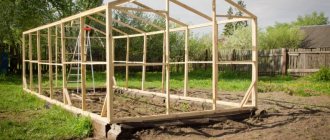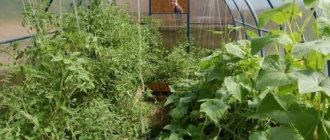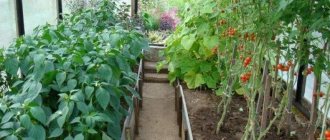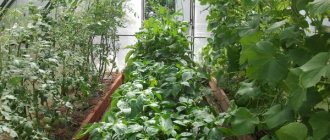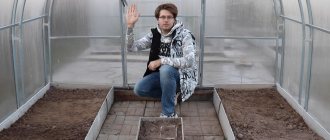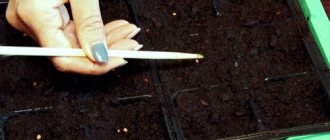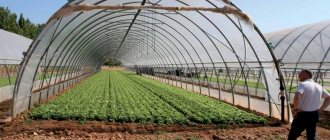Advantages and disadvantages of simultaneous cultivation
Of course, growing different vegetables together is quite possible. But, as you know, there is such a thing as cultural compatibility, desirable and undesirable proximity. Some vegetables cannot grow side by side simply because of the completely different conditions they require for normal development. These are criteria such as air humidity, light conditions, etc.
But if you still decide to grow different crops together, you should first understand the advantages and disadvantages of such planting.
- Among the main advantages, the following should be highlighted:
- saving greenhouse volume;
- savings in heating and lighting costs, which will inevitably increase when using several greenhouses;
- isolated soil is good for growing plants that require special care;
- Properly organized drip irrigation, as well as the use of vents, allow you to change the temperature regime and microclimate.
- It should also be said about the characteristic disadvantages of joint plantings:
- risk of cross-pollination;
- pests and diseases characteristic of one species can be transmitted to a neighbor;
- in a small space it is extremely difficult to create conditions acceptable for all inhabitants;
- the probability of thickening of the beds is quite high.
Plant height, watering and compatibility
- When placing vegetables, try to place tall and low crops side by side. It is important that some plants protect others from overheating. So spinach and lettuce need shade. Corn will be a faithful companion for pumpkins and cucumbers. This vegetable makes the microclimate for crops located in the lower tier much better.
- When it comes to watering vegetables, completely different rules apply. It is recommended to place in the same bed those plants that have the same watering requirements.
Completely undemanding to the presence of moisture:
MoyaTeplica.ru
Placing crops in a greenhouse
By planting different crops together in a greenhouse, one of them is made the main or base one, the rest are companions to the base vegetable. Cucumbers or tomatoes are most often used as the main dish.
Growing two different species together, which require opposite conditions, is a difficult task, quite difficult to accomplish, especially in the small volume of a small home greenhouse.
Did you know? The leading country in the number of greenhouses is Holland. If you add up the area of all the greenhouses located in this small state, even by European standards, you will get a rectangle with sides of 10 × 10.5 km.
Tomatoes absolutely cannot tolerate high air humidity; the most moderate watering is enough for them, and they need potassium-phosphorus fertilizers. Cucumbers need abundant watering and a microclimate with high, almost one hundred percent humidity. A lack of moisture has a detrimental effect on them: the fruits become smaller and acquire a bitter taste. It is preferable to fertilize the vegetable with nitrogen-containing organic matter (dung, mullein).
So for the normal growth and development of various crops, you should think about their placement in advance , but for this you need to know which species can grow nearby and which cannot. The same tomatoes can be separated from cucumbers by a partition, which will make it possible to create a zone with a more humid microclimate or, conversely, a drier corner in a greenhouse with high humidity. The partition should be made of moisture-proof material, for example, polycarbonate.
Video: What can be planted in one greenhouse
Companion plants
Next to crops that have a long growing season and fruiting period, the following grow well:
- White cabbage;
- salad;
- green onions;
- radish;
- spices.
When growing cucumbers and other crops together, it should be taken into account that many varieties of cucumbers stretch upward quite strongly. For this reason, it is better to plant cucumbers in the middle, and for example, squash and zucchini - at the edges. This way, cucumbers will not shade other vegetables.
Below are some crops that get along well nearby:
- tomatoes - cabbage, corn, onions, leeks, carrots;
- cucumbers - cabbage, kohlrabi, onions, corn, dill, legumes, beets;
- radish, radish - peas, strawberries, kohlrabi cabbage, carrots, parsnips, tomatoes;
- cabbage - strawberries, carrots, cucumbers, tomatoes, radishes, lettuce, spinach, celery, dill, beans;
- potatoes - beans;
- carrots - peas, strawberries, cabbage, onions and leeks, tomatoes, radishes, lettuce, spinach;
- spinach is well compatible with almost all crops, except beets.
Plant enemies
Some plants cannot be called very compatible, but they are not enemies either; rather, their proximity in the garden bed can be called acceptable or permissible. Such pairs include, for example, tomatoes and strawberries, potatoes and radishes, cucumbers and parsnips.
But there are plants whose joint cultivation in a greenhouse is extremely undesirable; with good reason, they can be called enemies. Particular attention should be paid to such a point as the complete incompatibility of cultures. The following combinations can be distinguished from the most characteristic antagonistic plants:
- tomatoes - peas, potatoes, cucumbers, dill;
- cucumbers - tomatoes, potatoes, radishes, radishes;
- cabbage - onions, leeks, peas;
- potatoes - cucumbers, tomatoes, beets, celery, peas;
- carrots - beets, dill, beans;
- radish, radishes - cucumbers, onions.
Important! Lettuce should not be planted near crops that are particularly susceptible to pests, as it attracts slugs. But greens, on the contrary, can repel pests. In addition, it takes up little space and is quite expensive in winter. By growing greens for sale, you can significantly increase the profitability of the greenhouse, recouping part of the maintenance costs.
When to plant greens in an unheated greenhouse. Early greens from our own greenhouse
The season in the greenhouse opens with cold-resistant, early-ripening crops: radishes, dill, watercress, Chinese cabbage, lettuce and salad mustard.
Radish
The first radish harvest in an unheated greenhouse can be harvested by May 9. To do this, seeds begin to be sown back in March, scattered, over snow thrown on
is a light-loving crop, so the sunniest place in the greenhouse is selected for it. It develops best on nutritious, humus-rich and loose soils. The most important element for radishes is potassium. It can be provided by adding potassium sulfate or.
Experienced gardeners advise sowing only large radish seeds in the greenhouse, since small ones shoot quickly. Unused small seeds can later be sown somewhere in the garden under trees to produce salad greens.
You should not sow a large area with radishes at once: the harvest may be so good that you “cannot handle it.” It is better to carry out repeated sowings at intervals of two to three weeks, so that the radishes arrive on the table in a continuous vitamin conveyor.
Radish varieties are divided into early-ripening spring and summer-autumn varieties. Description of the variety so that the result does not disappoint you. In the first year, you can sow many different varieties and see which ones bear fruit best in your conditions. The next year, sow those that have proven themselves well, leaving a small area for testing new varieties.
Dill
Dill will grow well in the garden without any shelter. But lovers of its greens sow dill in greenhouses already at the beginning of April, and then repeat sowing every 15-20 days, gradually moving on, in order to always have tender fresh greens. Harvest dill as needed, pulling out the bushes by the roots every 3-4 weeks.
Beijing cabbage
Beijing lettuce is often confused with Chinese and collard cabbage. Cold resistance, shade tolerance, early ripening, productivity and the fact that, unlike lettuces, it does not taste bitter even during flowering.
There are leafy ones. Leafy ones are usually grown in greenhouses because they are the fastest ripening of all: their growing season is 45-50 days. If leafy Chinese cabbage is planted in a greenhouse not as seeds, but as seedlings, the harvest can be obtained even faster.
Seeds germinate at a temperature of 3-4°C, plants can withstand frosts down to -4°C. The most favorable temperature for growth and development is 15-20°C. Chinese cabbage is shade-tolerant; moreover, it bolts less in the shade. It is removed selectively, as needed, thereby providing additional thinning.
Salad
There are many varieties: leafy, half-headed, cabbage, romaine, asparagus. The earliest of them are leafy. They form a powerful rosette of 5-10 leaves within 20-30 days after emergence.
Leaf lettuce seeds germinate at a temperature of 4-5 °C, the most favorable temperature for growth is 15-20 °C.
The lettuce is light-loving; in insufficient light the plants stretch out. Leaf lettuce is harvested selectively; if necessary, individual leaves can be picked first. When the rosettes have grown enough, cut off the entire plant with a knife. After harvesting, do not wash the lettuce, otherwise it will rot.
It deserves a special mention among leaf salads. This is a very tasty, early-ripening, cold-resistant, spicy green, ready for use within 2-3 weeks after sowing. Within two weeks you can begin to cut off individual leaves, and before flowering (25-30 days after emergence) the entire plant is pulled out. Sowing can be repeated all summer, until late autumn, and can also be sown before winter. Late autumn plantings may self-seed.
Leaf mustard
Salad mustard is very unpretentious. This is a cold-resistant crop, the seedlings of which can tolerate short-term frosts. Mustard is characterized by early ripening; harvesting can begin 25-35 days after sowing. Mustard is not very demanding on soil; moreover, it is an excellent
in the greenhouse as early as possible in the spring, while it is not occupied by heat-loving crops. Sowing depth is 1-1.5 cm, rows are 25 cm apart, the interval in the row is 18-20 cm. The optimal temperature for mustard, at which shoots appear on the 3-4th day, is 18-20 ° C. Mustard can be sown not in rows, but scattered, thinning out after 5 cm, and then after 10 cm.
Mustard has a shallow root system and is moisture-loving, so it may require regular watering. If there is a lack of moisture, mustard may bloom prematurely, and the leaves will become small and rough.
For a family of four, a mustard bed of 0.5 - 1 square meters is enough. m. It can also be sown as a compactor for most garden crops.
Preparing soil in a greenhouse
Growing different crops together requires special preparation. The top layer of the substrate is changed every year, the soil is spilled with a solution of copper sulfate or potassium permanganate before planting. Fertilizers are added to the substrate: humus, sifted ash, a little superphosphate and potassium sulfate.
If you are growing seedlings in a greenhouse, organize a separate area for this purpose. When you transplant seedlings to a place of permanent growth, make sure that they are absolutely healthy. If pest larvae or disease symptoms are found, the seedlings should first be cured and only then planted.
The most acceptable is the joint cultivation of hybrids with early ripening periods. Typically, such hybrids have high yields and disease resistance. As preventive measures, from the moment of planting, young plants are regularly treated with a pink solution of potassium permanganate, Fitosporin or other drugs that have a similar effect.
Interior arrangement of greenhouses
The layout of the interior space of the greenhouse depends on its purpose and size. For the greenhouse itself, a place is selected so that the sun's rays illuminate it throughout all or most of the day. When growing low-growing plants (seedlings, peppers, bush tomatoes, greens), the greenhouse is placed so that the beds are directed from north to south. In mixed plantings with some plants grown on trellises (cucumbers, tall tomatoes, zucchini), it is better to place the beds from west to east to ensure uniform illumination of the crops.
Rules for caring for plants
Caring for plants in a greenhouse has its own characteristics and differences from activities carried out in the open ground. Separately, it should be said about the nuances of caring for jointly grown crops.
Did you know? In 1240, Wilhelm, Count of Holland and Zealand, arrived in Cologne on a visit. In his honor, the first European winter garden-greenhouse was organized, where luxurious flowers grew and bloomed, while it was frosty outside. This performance impressed the audience so much that the Inquisition accused Albert Magnus, the botanist who staged the unprecedented show, of having connections with the devil.
Watering and humidity
Organizing optimal humidity is perhaps the most important and difficult task when growing various crops in one greenhouse. First of all, you need to know exactly what kind of watering and air humidity a particular crop needs , and, based on this information, plant the plants.
Species that require good aeration are located closer to the windows and doors (tomatoes). The same applies to vegetables that tolerate cold well (cabbage, beans).
If you want to grow completely incompatible vegetables that require completely different humidity conditions (tomato-cucumber, cabbage-onion), you will have to make partitions. In principle, there are no particular difficulties in making two compartments in one design, especially if the greenhouse has two doors on opposite walls.
What plants will be good neighbors?
So, let’s summarize the above and try to figure out which plants will grow well in the neighborhood:
- tomatoes will “make peace” with herbs (parsley, basil, celery, lettuce), garlic, green beans, peas. Can be combined with early white cabbage and radishes, melons and watermelons;
- cucumbers will accommodate bell peppers if they are planted closer to ventilated areas, as well as eggplants. All three cultures love warmth and are not afraid of humid air. Cabbage will also like the “cucumber” neighborhood;
- Zucchini grown in a greenhouse will begin to bear fruit much earlier than garden vegetables. They are not mischievous at all and are happy to have all their neighbors. The only drawback is that they take up too much space, which is already scarce in the greenhouse;
- Strawberries get along well with herbs, cucumbers and garlic. But cabbage and berries are incompatible.
Important! Not only different types of vegetables and berries can be incompatible, but also different varieties of the same crop. Before planting, you need to familiarize yourself with the growing conditions.
Over time, you can learn to accurately distribute seedlings so that all plants feel comfortable. New knowledge and practical experience will help with this.
Crop rotation in a greenhouse
The circulation of various crops in a closed, limited volume of a greenhouse can solve the problem of growing various vegetables together. During the year, you can alternate different crops, growing more or less compatible crops. All vegetables grown in a greenhouse are divided into:
- basic;
- intermediate (sealing);
- winter ones
The preceding ones are cold-resistant green crops that have a quick ripening period (spinach, all types of salads and salad-type vegetables, for example, Chinese cabbage, dill, radish, early carrots).
The main ones are vegetables that ripen for a long time and love the sun (tomatoes, cucumbers, peppers, eggplants). Seedling material of the main vegetable crops can be planted according to the previous ones. For example, tomatoes can be planted over spinach. As the seedlings of the main vegetable grow, the previous one that grew before it is gradually removed.
Compaction crops can be planted between rows or along the edges of main plantings. Such vegetables include lettuce, mustard, radish, Chinese cabbage, and leeks. Vegetables of this type are grown until the main crop grows. As the same cucumbers grow, the lettuce and leeks growing along the edges are gradually removed, freeing up space for the growing bushes.
Did you know? The prototype of modern greenhouses can be considered the ancient Roman carts in which residents grew flowers. During the day they were taken out into the sun, and at night they were placed in warm sheds.
Basic rules for intercropping
When combining vegetables, even if they have excellent biological compatibility, competition for nutrition, light and water may occur. You can nullify it if you follow the principle of complementarity.
This means that it is better to plant vegetables in the same bed that have different light and nutritional requirements. So it would be advisable to plant a plant with a low need for the same substances near a crop with a high need for nutrients.
The main crop is usually located in the central part of the greenhouse. Here the conditions for food will be better. Accompanying crops can be placed in other parts of the greenhouse.
We also recommend that you familiarize yourself with the article: methods and rules for arranging plants in a greenhouse.
The compatibility of plants also depends on their attitude to heat.
Maximum fruiting in the greenhouse
In order to get the maximum yield in the greenhouse, it is better to alternate different crops or plant the most compatible ones , creating the most optimal conditions for them.
For example, radishes and radishes are good to grow in early spring, at the height of vitamin deficiency, when fresh vegetables are needed. This is an early ripening crop that, in good light, can produce a harvest in 19–20 days. In addition, radish tolerates cold well, feels normal at +2°C, although the most favorable temperature for it is +16...+18°C.
The crop is undemanding in care, occupies a small area and is characterized by early ripening - it is for these reasons that radishes and radishes are good companions for many vegetable crops
In addition, cabbage, kohlrabi, and tomatoes get along well next to radishes. And if radishes ripen quickly, then the listed vegetables require much more time and sunlight. By growing them together, you can harvest radishes, creating ideal conditions for them and their companions, and then work closely on tomatoes and cabbage, which also get along well.
We also advise you to read about the technology of growing champignons in a greenhouse.
Cucumbers. The vegetable has quite moderate care requirements, and most modern hybrids also have high yields. All varieties and hybrids of vegetables require abundant watering and high air humidity . The cucumber cannot stand the cold; it is not recommended to ventilate the room more than two or three times a week. They love nitrogen fertilizing (a solution of manure, droppings). The most acceptable temperature after the first ovaries form is 25...+28°C, but temperatures above +30°C can be detrimental to the crop.
Video: How to prolong the fruiting of cucumbers in a greenhouse
Growing cucumbers can be combined with squash, zucchini, cabbage, onions, eggplants and peppers . Crops require largely similar conditions, which are quite simple to create: cabbage and peppers are placed near the door and walls, cucumbers are grown in the middle of the room. Cabbage tolerates cold well, so periodically opening the door will not interfere with its growth. Pepper needs more sunlight - it is advisable to place it near a south-ventilated wall.
What is mixed planting
Mixed plantings involve placing vegetable crops on a small plot of land that have a beneficial effect on each other, taking into account their characteristics. When planting, be sure to follow the rules for arranging plants with each other, taking into account their height, size and ripening period. They should not suppress each other’s growth, but create a certain microclimate or be protection from sunlight or wind.
Advantages of mixed vegetable plantings
Growing several types of plants in one place reduces soil fatigue and makes it possible to abandon annual crop rotation. Planting in compliance with all compatibility rules will increase the yield several times by the end of the season.
The main advantages of mixed plantings:
- proper placement of vegetable crops allows harvesting from early spring until the first frost;
- The area of land allocated for a vegetable garden is used more rationally, from 1 sq.m. you can get up to 20 kg of vegetables with the right combination;
- vegetable crops feed on different elements contained in the soil, which helps to avoid unilateral depletion of the soil;
- substances secreted by the roots of one plant influence the taste and size of the neighboring vegetable, stimulating or suppressing;
- the mixture of odors emitted by leaves or fruits of different crops plays the role of chemicals that repel pests or prevent them from finding the desired plant.
Conditions for mixed plantings
Mixed plantings are part of biodynamic farming, which means growing vegetables and berries only using natural forces, without resorting to chemicals and artificial fertilizers. To get as much harvest as possible from each piece of land, follow these tips when planting in a mixed way:
- The width of the future bed should be 1 m. This is the optimal size for further convenient processing and sowing.
- The main, long-ripening crop is planted in the central part of the bed. It could be tomatoes or cabbage. By the end of the season, its growth will increase significantly, and it will occupy the area of the entire bed.
- Something that ripens quickly is planted on the sides of the bed. Such friendly crops can be greens - spinach, radishes, green salad. They are compatible with almost all vegetables and stimulate their growth. While the main crop grows, the side crops will already be collected and space will be freed up.
- Plants for lateral planting are chosen to be small and stunted, with a small root system.
- To protect against pests in an organic way, herbs with a strong aroma are planted in the garden bed - sage, basil, coriander, lemon balm or mint. There should be a lot of them so that the spicy fumes can repel pests and attract beneficial insects.
Undesirable neighborhood for vegetables
When different crops or varieties are grown in one area, an exchange of chemical compounds occurs between them and the plant next door has a direct impact on the quality and quantity of the crop. Before making a plan for planting vegetable and berry crops, figure out what placement should be avoided.
Cucumbers and tomatoes are not planted next to each other. Tomatoes require constant ventilation, and cucumbers require heat and high humidity.
Tomatoes are bad neighbors; they inhibit the growth of vegetables growing nearby. Such proximity does not have a negative effect only on garlic, beans, radishes and greens. Beans and vegetables such as carrots should not be placed next to cabbage; they inhibit the growth of each other. Place celery next to it and get a good harvest of both crops.
Sage and legumes should not be planted near the onion bed; they have an adverse effect on its growth and taste. For potatoes, cucumbers, celery and pumpkin are bad neighbors; close placement of tomatoes is also undesirable. You will not be able to get a good beet harvest if dill or potatoes are planted next to it.
Preparing the greenhouse for winter
In order for the greenhouse to serve you properly and for a long time, at the end of the season it must be prepared for winter. The primary task of this event is cleaning the premises. Choose a day without precipitation when the weather is calm. Remove all plant debris from the beds - both above-ground parts, roots, and everything else.
All annual plants are removed, perennials (strawberries) are carefully examined for the presence of dry, damaged branches, and signs of disease. If such are found, the plants are removed and young ones are planted in their place in the spring.
Read more about how to properly prepare a greenhouse for winter.
When you have dealt with the plants, you need to move on to the soil. The task is quite labor-intensive and responsible. The top layer of substrate (15 cm) under the annuals is changed every season. It is better to take the removed soil away from the garden. You can replace the removed soil with a purchased one, but it is better not to do this (perhaps they will sell you the same removed, sifted substrate, only with its own diseases and bacteria).
The soil that will be laid instead of the removed one must meet the following requirements:
- have the correct structure, not too small and moderately large fractions;
- rich in humus;
- do not contain any mineral fertilizers (the initial substrate must be empty, fertilizing is added later);
- have good moisture absorption;
- have neutral acidity (pH about 7.0):
- must be disinfected.
Preparing beds for greenhouse planting
As you know, the main purpose of installing polycarbonate shelters is to obtain early vegetables and herbs and extend the harvest period. This is especially true for the northern regions, where warm days begin only in June and can end as early as August. Early greens and greenhouse vegetables are much more expensive than seasonal ones. In order for the greenhouse to “work” as long as possible and provide a decent result, you need to create maximum comfort for the plants:
- Separate the boxes with nutrient soil from the surrounding soil. For what? Everything is easily explained by the laws of physics. No matter how well the greenhouse was heated, no one canceled the heat exchange. Imagine that outside it is already (or still) frosty, 10 degrees, and inside it is full summer, created by heaters. If the soil in the greenhouse comes into contact with the frozen ground outside, then heat is lost and plant roots suffer from the cold. The result is that the tops are in the heat, and the roots are in the cold. From such dissonance, plants get sick and die.
- Create “warm” beds. In industrial greenhouses, the soil is poured onto a water or film heated floor, but in a summer cottage such options are unprofitable. Experienced gardeners use alternative “biofuels”. On top of the drainage, approximately 2/3 of the volume of the box is laid out with a layer of branches, large weed stems, leaves, straw and fresh manure (preferably horse manure). The top is filled with the prepared soil mixture and thoroughly spilled with hot water or solutions of mineral fertilizers. After this, the bed is covered with film, “launching” the process of natural heating. Gradually overheating, organic matter releases heat that warms the roots and additionally enriches the soil with nutrients.
- Protect plantings from pests and rodents. If moles, mole crickets and mice are often found on the territory of a dacha village, then do not be lazy and place a fine-mesh metal mesh under the beds. It will protect the plants from pests that find satisfying food and settle down for the winter in warm boxes.
When filling high beds in multiple layers, a layer of branches (1) is placed on the bottom, then fresh manure and vegetable compost (2), and a fertile soil mixture is placed on top (3)
For full-fledged warm beds, the height of the box will be at least a meter, where 30 cm is large branches with unrotted manure, 30 cm is small organic matter with leaves and wood chips, and 40 cm is a mixture of earth with humus, peat, sand for plant roots.
Of course, the prefabricated structure does not have to be mounted entirely on the surface. Taking into account the groundwater level, you can deepen the boxes, providing drainage, or “drown” the passages, creating a kind of heat collector. There are a lot of options, but they need to be chosen taking into account the characteristics of a particular site and the climatic conditions of the region.
How to properly divide a greenhouse into zones for different plants?
Each type of plant requires certain conditions for normal development and fruiting. From this point of view, placing plants that are different in relation to the environment in a confined space is a rather difficult task. To facilitate the selection of plants and create normal conditions for their growth, development and crop formation, the most appropriate zoning of the greenhouse will be.
It is practical to measure the temperature along the longitudinal walls of the greenhouse and highlight areas where the temperature changes. Separate these areas with any material, highlighting areas with higher temperatures and cooler ones. Usually the greenhouse is divided into 3 zones. If the greenhouse is heated, then the warm zone will be in the middle of the room, the warmest at the end and the coldest at the beginning, where the doors to the vestibule are constantly opened to perform certain work.
If the greenhouse is large, then the zones are separated with more durable material (plywood, plastic), and temporary doors are installed. In greenhouses with an area of 3.0 x 10.0 m, zones are usually separated by plastic film with slots for passage or an oilcloth screen. Insulation will help increase the humidity level in the area, maintain the desired temperature, and ventilate the designated area. Depending on the conditions for each zone, the main/basic and accompanying crops are selected for joint cultivation.
Filling the beds
If the natural soil in the greenhouse is heavy and dense, you need to remove the top layer and make a good drainage flooring from crushed stone, broken bricks and other waste. Pour prepared or purchased soil mixture on top. Such beds are usually installed in warm regions or in temporary structures. In colder regions, it is advisable to make insulated beds.
In such insulated beds, only the top nutrient layer, consisting of several components, must be replaced annually. The owner of the greenhouse can choose any method of insulating the beds.
In greenhouses where it is planned to grow 4-6 or more types of vegetable products, it is better to divide long beds into several zones, especially if the crops grown require different lighting, humidity and air temperature.
Ensuring Compatibility
Crop rotation in a greenhouse
In scientific terminology, compatibility refers to the process of crop rotation.
Such a problem will always be relevant in the process of growing vegetable crops in greenhouses.
In other words, compatibility can be determined by different optimal growing conditions for many varieties of vegetable crops.
For the normal development of some plants, high-quality watering is necessary, and for the development of others, the temperature should not fall below 20 degrees.
It is precisely because of the need to organize different development conditions for vegetable crops that it is recommended to install greenhouses designed according to different principles. If this cannot be achieved, it is better to ensure that each variety of vegetables is placed in a separate bed.
Experienced gardeners claim that on the same soil it is always possible to simultaneously grow different types of vegetable crops. During the exploitation of a land plot, it is imperative to ensure a regular change of plant species belonging to one crop to others. However, to achieve greater confidence in the future, you need to try to disinfect the soil after a particular variety of vegetation has given fruit.
Cabbage and strawberries
It is not recommended to plant garden strawberries next to or compact with cabbage of different varieties and varieties. The main reason for their antagonism is the cabbage’s high consumption of nutrients, which it takes away from its neighbor. In addition, cabbage requires abundant watering, which is harmful to strawberry bushes. An unfortunate neighborhood also attracts many slugs, which will damage most of the berry crop. But the main thing that distinguishes cabbage is that it is tall, compared to strawberries, with large leaves that shade all the low-growing plantings.
general information
Foundation for the greenhouse
After determining the dimensions of the greenhouse, the foundation is poured, after which the frame dries.
The process of covering a greenhouse can be called quite labor-intensive, but not particularly different in complexity.
All actions can be performed much easier if you act strictly according to the instructions that professional greenhouse designers provide for your reference.
When processing polycarbonate prepared for greenhouse design, it is imperative to take into account its usual size. Next you need to put marks on the places where the holes are drilled. You can even consider this article as an instruction, since it reflects a detailed algorithm for equipping a standard greenhouse.
It is imperative to take into account the dimensions of the polycarbonate greenhouse. You also need to remember that the installation of such a structure is considered only one of several main stages, the implementation of which is required to organize the normal operation of the greenhouse.
The frame is created from profiles onto which such slabs are subsequently fixed. To do this, you will need special clamps with seals, as well as thermal washers and covers that come with them. After all the components are assembled into one structure, you can deal with the issue of sealing and thermal insulation.
Experts recommend using regular cellular polycarbonate, the thickness of which must be determined independently. The quality of the material will always be preserved, and its installation will not require any special effort. If the shape of the greenhouse resembles a hangar, polycarbonate can easily adapt to it without any associated damage. In this case, it is imperative to take into account one very important requirement: the diameter of the fittings must be greater than the width of the holes for fastenings.
Greenhouse installation
When installing cellular polycarbonate, another profiled version of this material can be used.
It is imperative to take care of the lighting of the designed greenhouse.
A special mounting profile or ordinary aluminum corners can be used as a frame installed on an equipped foundation.
It is advisable to install such a frame so that it is highly durable and difficult to assemble. This is necessary to ensure the ability to withstand heavy loads.
In addition to the load-bearing elements, it is imperative to provide special stiffening ribs, thanks to which the structure will be sufficiently stable. The frame must be designed in such a way that multiple windows and doors can be installed.
